By Our Coreespondent
The Akoko-Edo Development Association (AEDA), also known as the Akoko-Edo Forum, has formally petitioned the House of Representatives Committee on Constitution Review, seeking the division of the existing Akoko-Edo Local Government Area (LGA) in Edo State into three separate administrative units.
In a detailed proposal submitted to the National Assembly, the association is advocating the creation of Akoko-Edo North, Akoko-Edo South, and Akoko-Edo Central LGAs. The group describes the current Akoko-Edo LGA as one of Nigeria’s oldest yet most underserved in terms of administrative restructuring.
In a cover letter accompanying the proposal and signed by its chairman, Dr. Charles Jagun, AEDA argued that the expansive size and diverse population of the present Akoko-Edo LGA make it administratively unwieldy and ineffective in delivering equitable development across its many communities.
Find the detailed proposal below;
Proposal for the Creation of Two (2) Additional Local Government Areas from Akoko-Edo Local Government Area of Edo State, Nigeria.
Introduction
Akoko-Edo Local Government Area is one of the largest local government areas in Edo State, Nigeria, with a land area of approximately 1,371 square kilometers, representing about 6.5% of the state’s total landmass. According to the 2006 population census, Akoko-Edo LGA had a population size of 261,567, which is projected to have grown to approximately 465,304 by 2024, based on the Nigeria Population Commission’s annual growth rate of 3.2%. This significant population size, coupled with the vast geographical expanse, presents administrative challenges and difficulties in effectively delivering basic amenities and services to the people. Akoko-Edo LGA is a culturally diverse area, comprising forty-two (42) communities with about fourteen (14) sub-ethnic groups and languages. It is bounded in the North-East by Kogi State, in the North-West by Ondo State, in the South-East by both Etsako West
LGA and Etsako East LGA, and in the South-West by Owan East LGA.
Key Facts about Akoko-Edo LGA:
● Land Area: 1,371 sq km (6.5% of Edo State)
● Projected Population (2024): 465,304
● Population Density: 249.9 per sq km (as of 2016)
● Number of Communities: 42
● Sub-Ethnic Groups and Languages: 14.
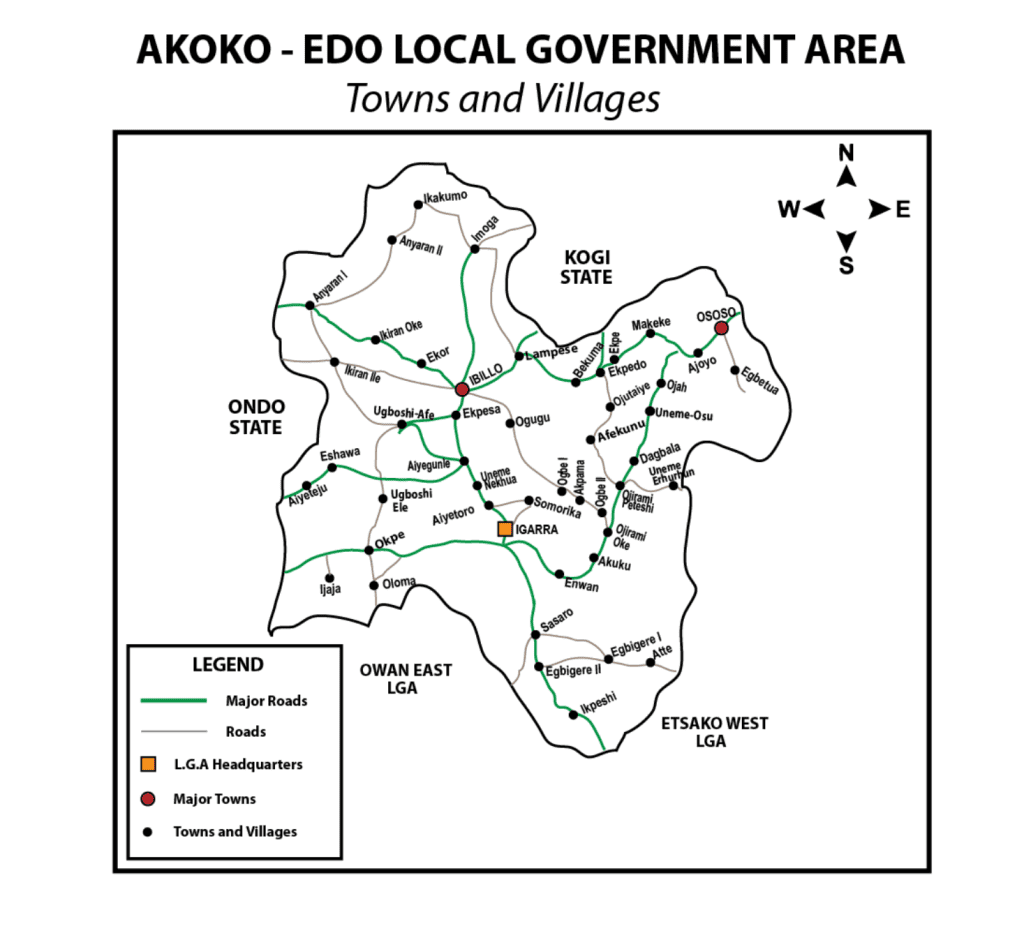
Historical Background
Akoko-Edo LGA created in 1963 has a rich historical background as one of the oldest local government areas in Nigeria. It was part of the former Akoko-Edo division, which, along with the former Afemai division, Esan division, and Benin division, constituted the present-day Edo State. While the former Afemai division was later divided into five (5) local government areas, the former Esan division into five (5) local government areas, and the former Benin division into seven (7) local government areas, the former Akoko-Edo division remained as a single Akoko-Edo local government area. During the Second Republic (1979 – 1983) under the defunct Bendel State, the government of Ambrose Alli made an attempt to create three local government councils from the then Akoko-Edo local council, namely Central Akoko Edo Local Government Council, Akoko-Edo North Local Government Council, and South Akoko-Edo Local Government Council reflecting a recognition of the area’s size and population (Appendices I, II, III). However, this initiative was discarded by the subsequent government for political reasons.
Justification For Creation
Edo North Senatorial District currently has six (6) local government areas, including Akoko-Edo LGA, Etsako Central LGA, Etsako East LGA, Etsako West LGA, Owan East LGA, and Owan West LGA. The current structure disadvantages Akoko-Edo compared to neighbouring LGAs within Edo North Senatorial District. A comparative analysis of these local government areas in terms of land mass and current projected population figures (2024) reveals the following:
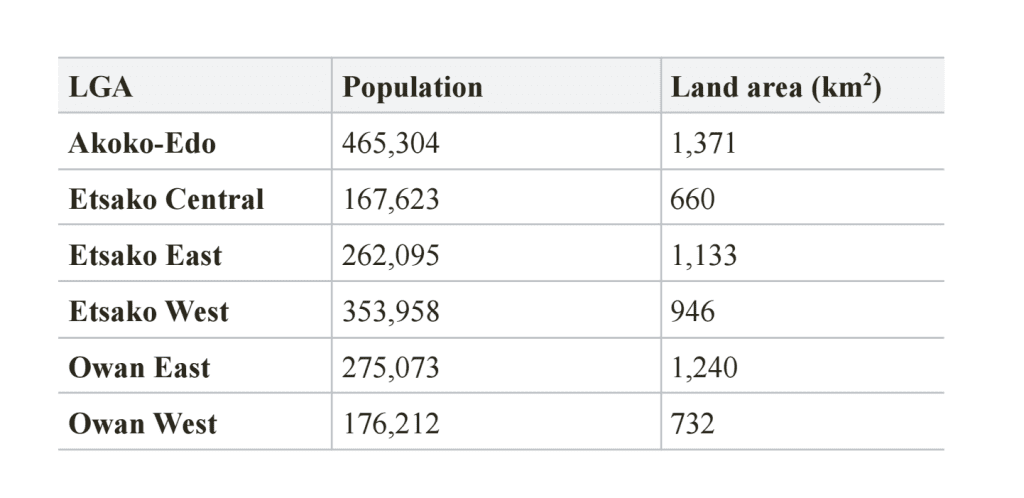
It is noteworthy that Akoko-Edo LGA has a significantly larger population and land mass compared to other local government areas in the same senatorial district. In contrast, the neighboring Ogori/Magongo local government area in Kogi State, which was created from the old Okene local government area, has a combined land area of only 79 square kilometers and a population of 65,845 by current projection.
The Proposed Local Government Areas
To address the administrative challenges and ensure efficient service delivery, we hereby propose to create two additional local government areas within the current Akoko-Edo LGA, resulting in a total of three local government areas:
1. Akoko-Edo Central LGA
Headquarters: Igarra
Igarra is the headquarters of the current Akoko-Edo Local Government Area. This proposed local government area is to be made up of the following neighbouring communities:
● Igarra
● Enwan
● Akuku
● Okpe
● Eshawa
● Aiyeteju
● Ogbaleshe
● Uneme-Nekhua
● Egbigere
● Atte
● Ikpeshi
● Sasaro
● Oloma
● Ijaja
● Akpama
2. Akoko-Edo North LGA
Headquarters: Ibillo
This proposed local government area is to be made up of the following neighbouring communities:
● Ibillo
● Lampese
● Imoga
● Ikiran-Ile
● Ikiran-Oke
● Ekpesa
● Ekor
● Ugboshi-Afe
● Ugboshi-Ele
● Aiyegunle
● Ogugu
● Ogbe
● Somorika
● Onumu
● Ikakumo
● Ayanran
3. Akoko-Edo South LGA
Headquarters: Ososo
This proposed local government area is to be made up of the following neighbouring communities:
● Ososo
● Ojah
● Dagbala
● Makeke
● Ekpedo
● Uneme-Osu
● Uneme-Erhunru
● Ekpe
● Bekuma
● Ojirami
Economic Viability Of The Proposed Local Government Areas
The proposed local government areas possess abundant natural resources, particularly mineral deposits, which can contribute significantly to their economic viability and self-sustenance. Akoko-Edo North is rich in granite, limestone, gold, and dolomite, offering significant potential for mining and industrial development. Similarly, Akoko-Edo Central boasts extensive deposits of limestone, marble, granite, dolomite, and other minerals, fostering prospects for sustainable economic growth. Meanwhile, Akoko-Edo South possesses substantial reserves of limestone, gold, and granite, promising avenues for investment and job creation.
Akoko-Edo Central
In the proposed Akoko-Edo Central Local Government Area, the following minerals are found in abundance in the respective communities:
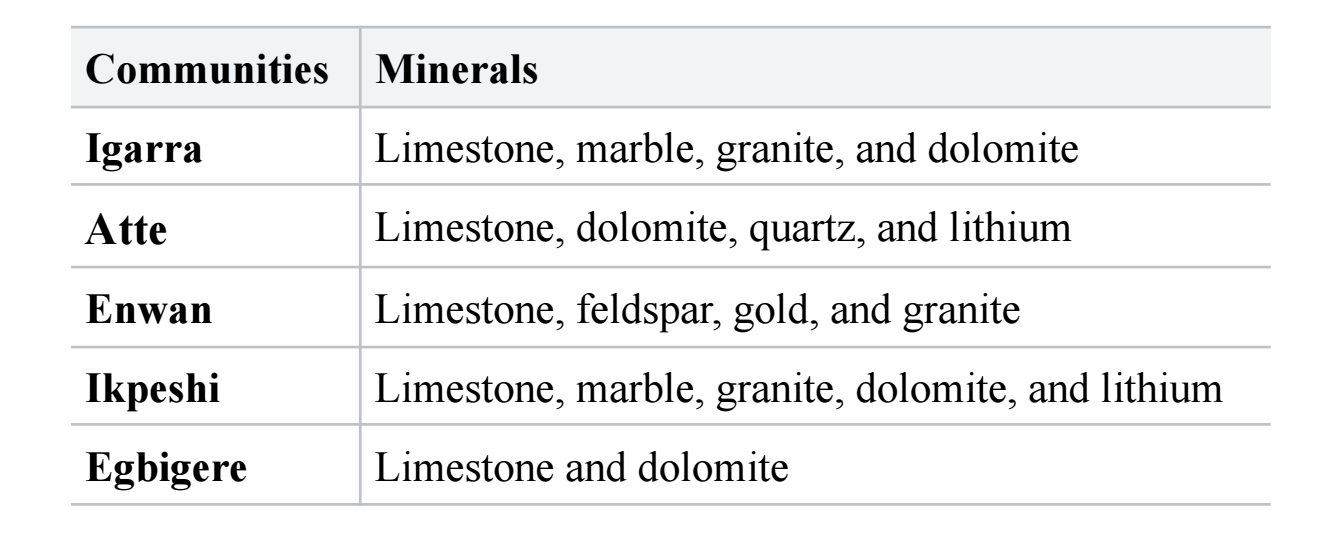

In addition to these solid minerals, this proposed local government area also has potentials in the agricultural sector as palm trees plantations and the palm oil processing ventures in Enwan and the Songhai farms in Okpe and Uneme-Nekhua. There is also the tourism potential as represented by the sexennial Irepa/Aba festival of Igarra community.
Akoko-Edo North
In the proposed Akoko-Edo North Local Government Area, the following minerals are found in abundance in the respective communities:
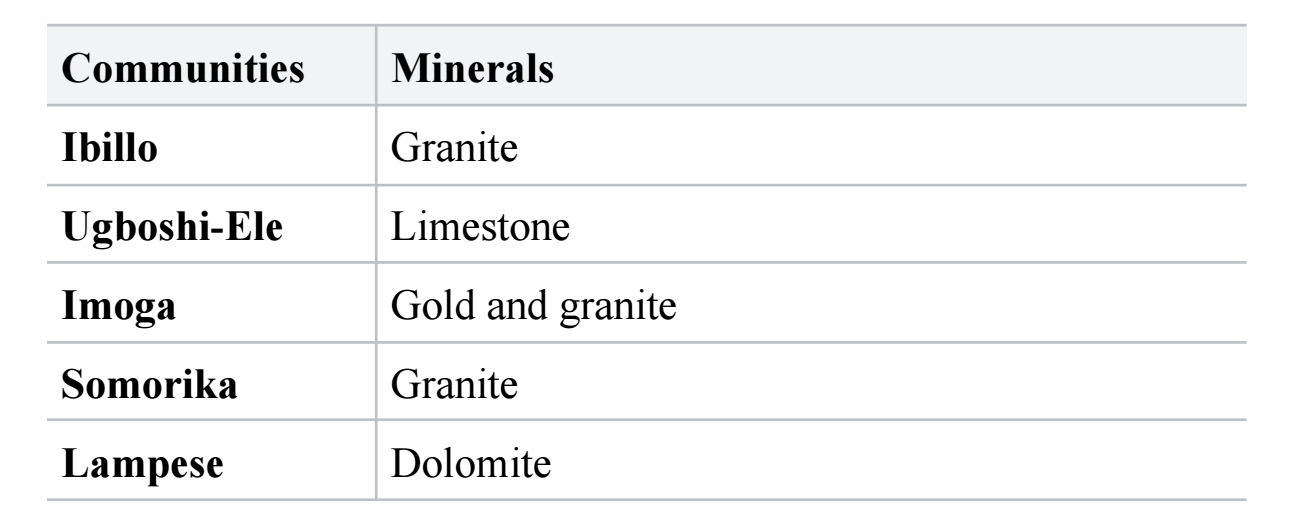
In addition to these solid minerals, there are also great agricultural potentials across the communities in this proposed local government area, notably the cassava and gari processing ventures in Ibillo.
Akoko-Edo South
In the proposed Akoko-Edo South Local Government Area, the following minerals are found in abundance in the respective communities:
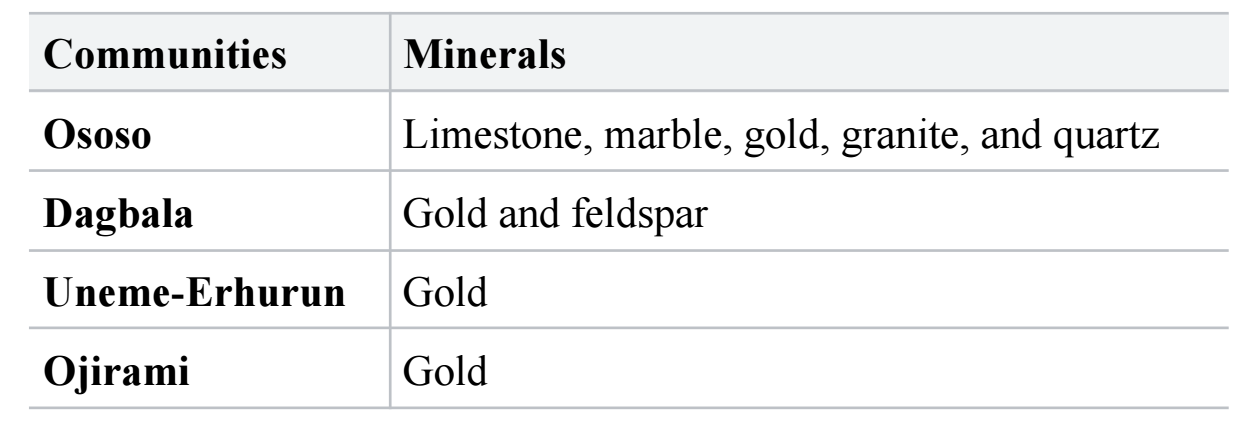
In addition to the presence of these solid minerals in this proposed local government area, there are also agricultural potentials across the various communities, notably the palm oil farms in Ososo. In terms of tourism, Ososo is also a tourist destination renowned for its picturesque rocks and the annual Ososo carnival. There is also the traditional pottery industry in Ojah community where a National Museum for Arts and Culture is sited. In Uneme-Osu, there are also thriving blacksmith industries. The exploitation and proper management of these natural resources can generate significant revenue for the proposed local government areas, fostering economic development and self-reliance.
Summary and Conclusion
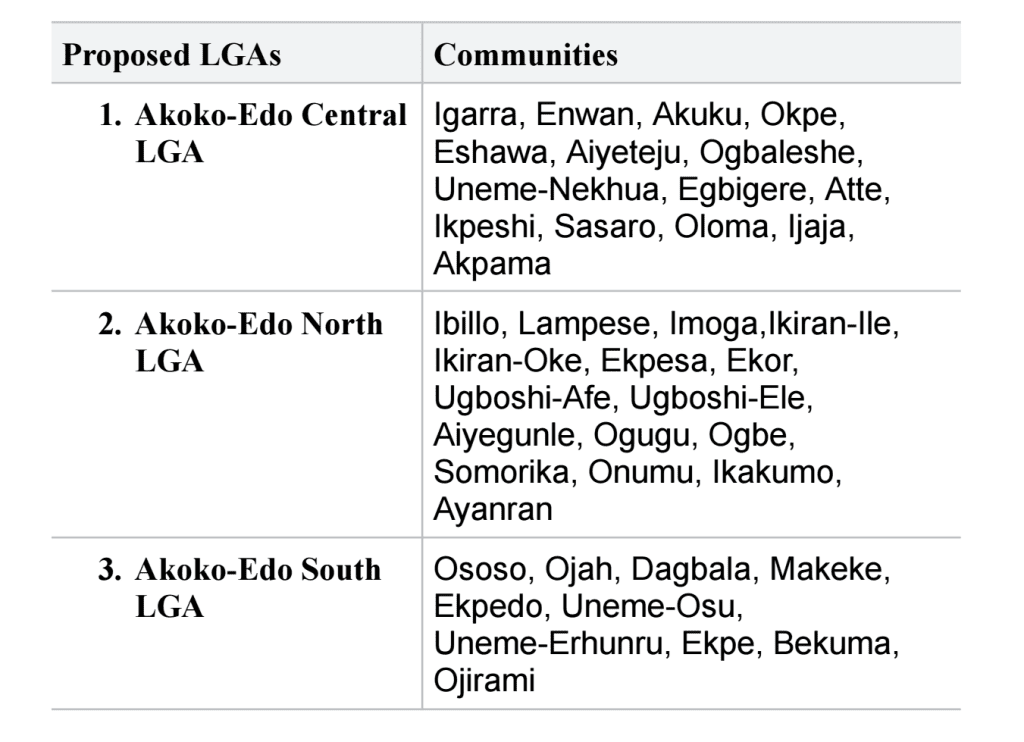
The establishment of Akoko-Edo Central, Akoko-Edo North and Akoko-Edo South as distinct local government areas in Edo State is imperative for equitable development, efficient governance, and harnessing the socio-economic potentials embedded within these regions. By decentralizing administrative functions and optimizing resource management, this proposal aims to foster sustainable growth, unlock the economic potential of the region, and elevate the standard of living for residents across Akoko-Edo.

